Why are Strongman Fat: Organism Adaptations, Proper Diet & Training
Author:
Reviewed by:
(21 years of Oly Lifting experience)
Unlock your full potential by engaging with our experts and community! Have questions about your fitness journey or looking for expert advice on weightlifting techniques? Don’t hesitate — leave a comment below and Sergiy Osipchyk will provide a personalized answer and insights to help you reach your goals.
Torokhtiy is reader-supported. Some links are affiliate links, and we may earn a commission at no extra cost to you. See our disclosure page for details.
Why do strongmen have big bellies? Having a tummy isn’t a big deal for these athletes as they eat around 5,000 calories a day and lift more than 1,000 lbs. Get to know strongmen’s secrets of preserving muscle and growing strength while keeping on gaining weight.
Defining why are strongman fat, we can claim that being bigger it’s easier to move against resistance, as the odd body weight breaks the inertia of a heavy object. While fat tissues facilitate compression generation helping to stabilize and absorb the kinetic energy through the body when lifting heavy weights.
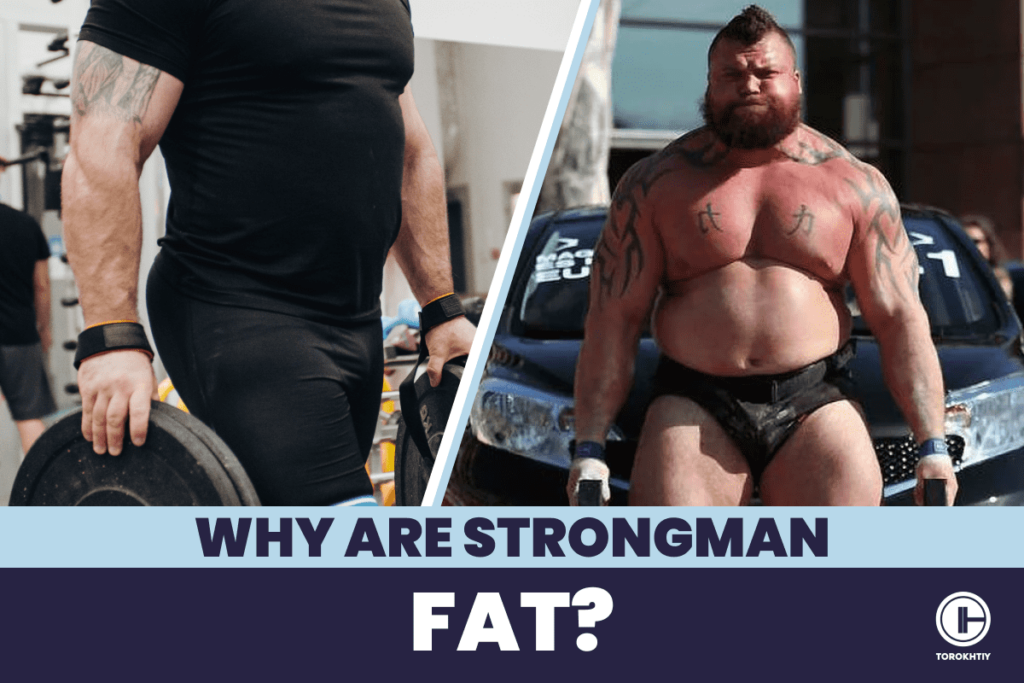
The Myth About the “Fatness” of Strongman
When we’re spectating such strength competitions like the World’s Strongest Man or Arnold Classic, we won’t see shredded and lean bodies with abs, we’ll see big bellies instead.
The same situation is with super heavyweight divisions in powerlifting and Olympic weightlifting: athletes with a big mass will likely prevail over cut muscular bodybuilders.
The majority would ask ‘Why are strongmen fat?’ – they are sportsmen who are constantly working out, is it an issue for them to cut weight and be more shredded? An athlete won’t build muscles without lifting heavy weights and being strong.
You may like it: Effective Strongman Training Program To Gain Max Strength
Strongman competitors try to keep more body fat because it helps them move more weight. Some fat also isolates their joints and other body parts from being injured. Since strongmen are prone to trauma, they tend to preserve a high rate of body fat.
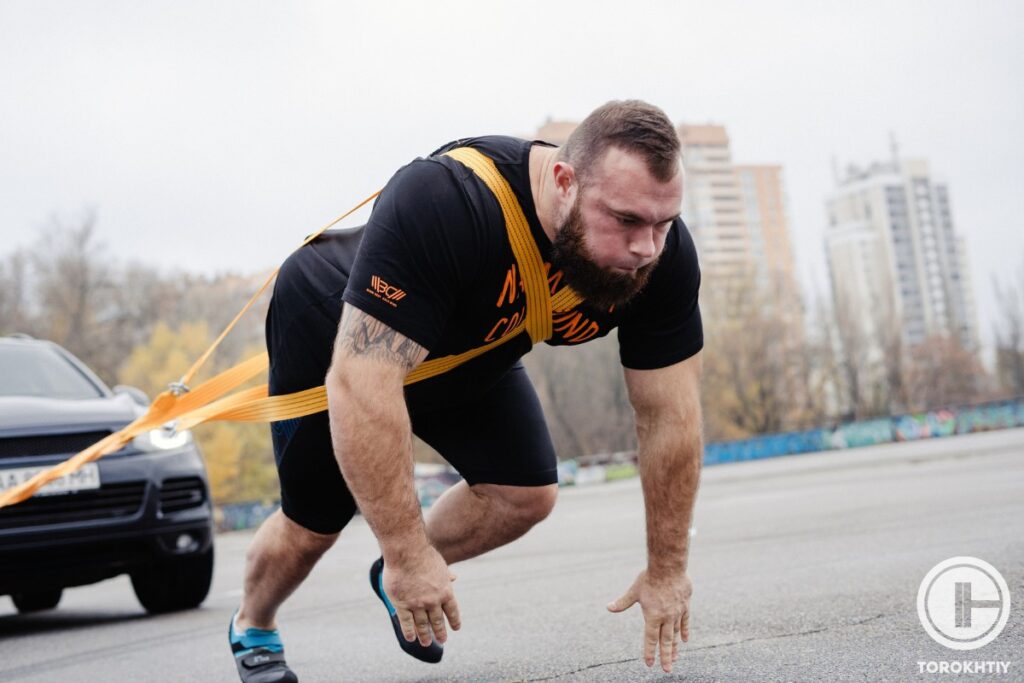
Unlike bodybuilders, strongmen don’t need to look shredded, because their sport requires strength indication before appearance. What’s more, they don’t follow some specific diet regime since they need to gain muscles by increasing their weight.
So, they eat whatever they want because nobody cares about their lean bodies.
In fact, strongman contests measure not just raw strength, but also momentum which is mass velocity, and potential energy which is mass elevation. When a strongman reaches maximum muscle mass, the only way to increase it is to add fat.
Unlike bodybuilders, strongmen demonstrate more technique than pure power, to deal with the weights. They possess functional strength and speed, thus being able to lift immense weight by using technique and speed, but not just muscles.
Having a body fat rate of up to 20% has some benefits. Since strongmen perform movements that greatly influence their muscles, bones, tendons, and joints, a certain rate of fat can protect them.
The majority can say that strongmen look fat because they have big muscles. In fact, they have a functional body that can withstand immense loads. In fact, when an athlete gains weight, they automatically gain muscles with the fat.
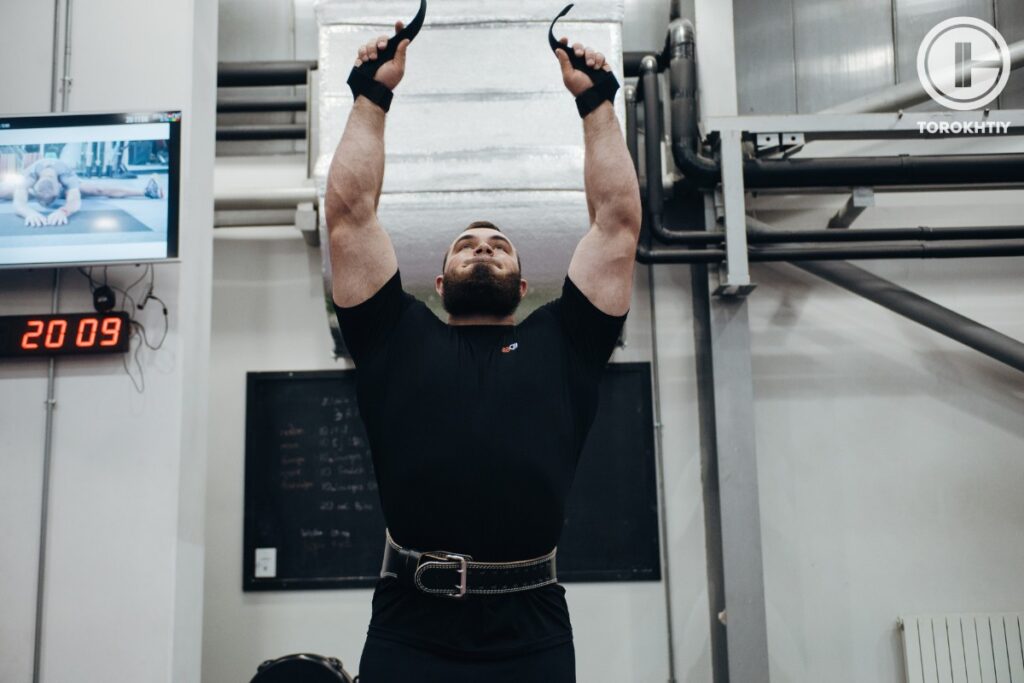
The body will naturally convert some of the excess calories to muscle mass due to testosterone. Also, when working out, the body will convert much more calories to muscle in relation to fat.
The next point is that in order to build muscle mass, an athlete needs to gain a caloric excess. It promotes better and quicker recovery from training and general well-being. In theory, it’s possible to calibrate the meal intake precisely to consume the exact amount of food to build muscle mass.
When preserving a diet, a sportsman loses muscle mass and strength. That’s why to maximize strength, strongmen never follow a diet to lose weight because they sacrifice their strength.
Lifting weights means burning hundreds and even thousands of calories. Hence, the body needs a calorie surplus to build muscle mass. That’s why eating is part of the strongman training routine.
For strongmen, cutting too much weight means a detrimental loss of pure strength. So, they never cut weight, especially before the competition. For instance, competitive lifters have a weight, at which they feel themselves strong.
While bodybuilders dehydrate themselves to lose body fat since it’s an aesthetic sport. That’s the reason why strength athletes do not cut their body fat because they can put it on to get good pushing and pulling capabilities.
There’s also a clear rule: the more weight you have, the more weight you can move. You will be stronger at a high body weight. While being heavier lowers the work capacity, so strength athletes try to maintain a balance between body weight and sufficient work capacity. So, that’s why strongmen have more body fat than bodybuilders.
Follow us!

Free!
Get a 2-week Weightlifting Program as a bonus for the subscription to kickstart your training plan!

Free!
Muscle Mass vs Fat Mass
The skeletal muscle helps to control body movements. These are also fuel storage that gives the energy for exercising. Increasing your muscle tone and quality will help you maintain a healthy weight, move more, burn calories faster, and avoid injury.
While fat is also an energy store, it protects your body and supports the endocrine system, releasing hormones and proteins that regulate other organs’ performance and processes in our bodies.
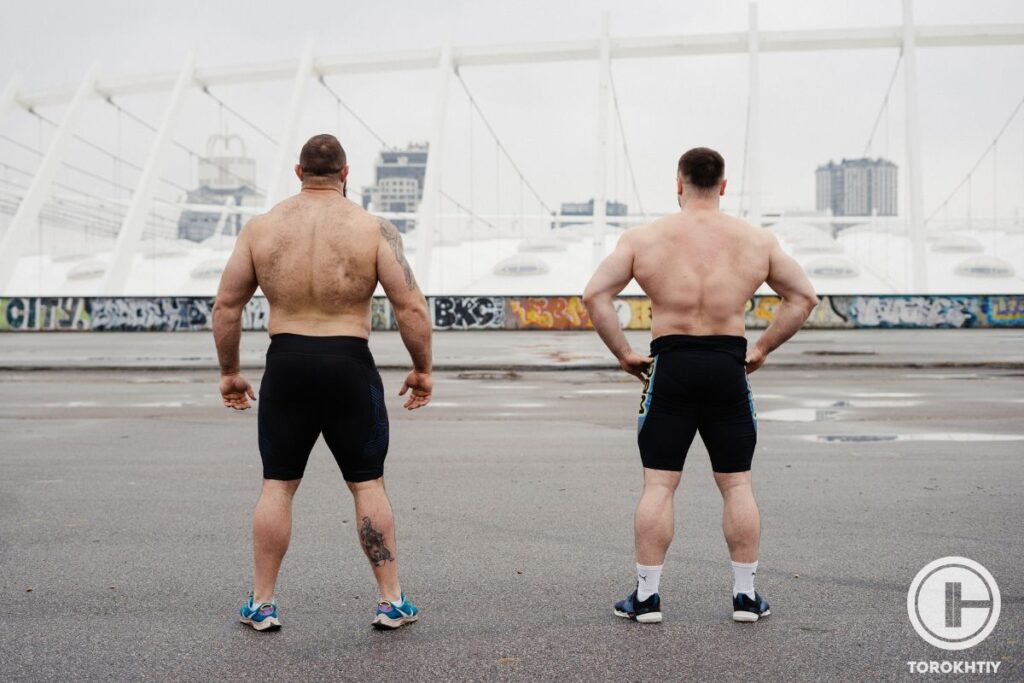
A kilo of muscle is the same as a kilo of fat, but the fat will have a greater volume, while the muscle fibers will have a greater density. So, a kilogram of muscle will take up less space and look smaller than a kilogram of fat.
Muscles are built of contractile fibres to facilitate movement and vouch for overall strength, while fat tissues are an energy store.
Muscles aid significantly in burning calories facilitating the process of weight management, while fat doesn’t participate in metabolic processes. Also, muscle tissue is denser than fat, which occupies less space and influences body composition.
So, the key role of energy source for strongmen is muscle fibers, namely glycogen which is stored in the muscle tissues, and glucose as well which is used while training. The reason is the process of anaerobic glycolysis that serves for energy production in cells.
While body fat serves for various processes: from regulating glucose and cholesterol levels to promoting immunity. Excess fat can lead to obesity and increase the risk of diabetes, cardiovascular disease, and even cancer.
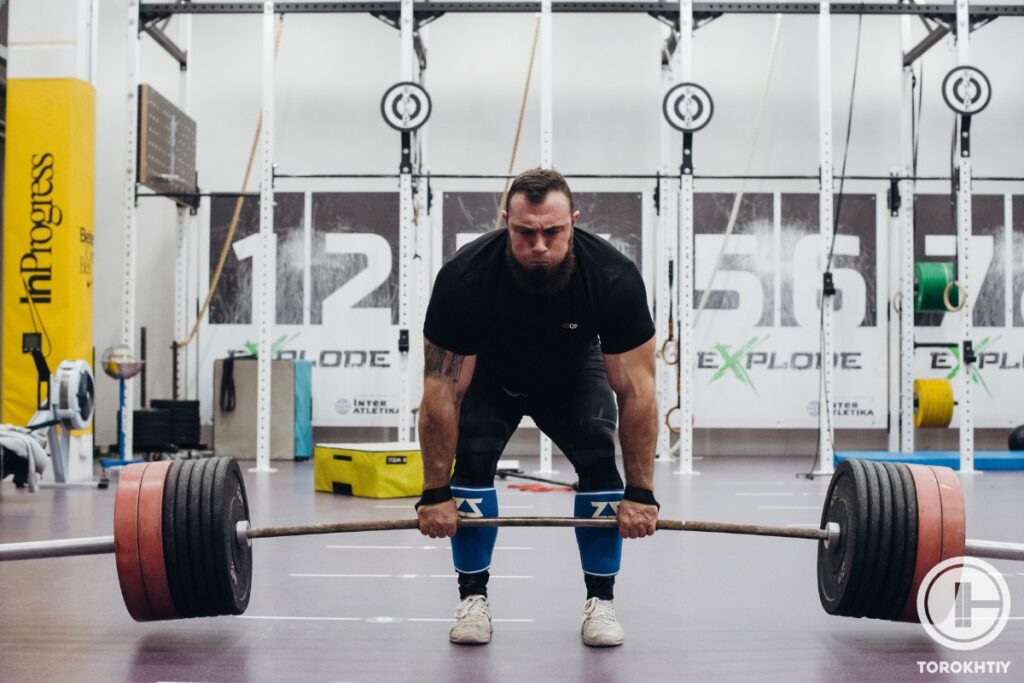
Speaking about the strongman body fat percentage, let’s analyze the case of 2023 World’s Strongest Man Mitchell Hooper who discussed his consultation with bodybuilder Greg Doucette, who claims that a perfect body fat percentage of a strongman is around 30%.
On the contrary, muscle tissue refers to being metabolically active, meaning it requires energy to maintain itself, i.e., muscles burn calories. Building up and keeping muscle mass is important for your overall health and for enhancing your physical abilities.
How a high percentage of muscle mass in strongman athletes can create the impression of a larger body?
To start with, the process of gaining weight connects greatly to a calorie surplus and proper exercise selection. So, there’s no need to ask the question ‘Why do strongmen look fat’ anymore.
Strongman training engages the whole body, along with a coordinated effort of will and muscle to challenge the body. So, it stimulates massive muscle growth over the body as it adapts to the extreme stimulation of the full body, by lifting odd objects.
Gaining muscle mass along with gaining fat will be much faster than applying any lean muscle gain method. Thus, it’s true to state that mass moves mass. The thing is that the more body fat rate is the more muscles an athlete will be able to grow.
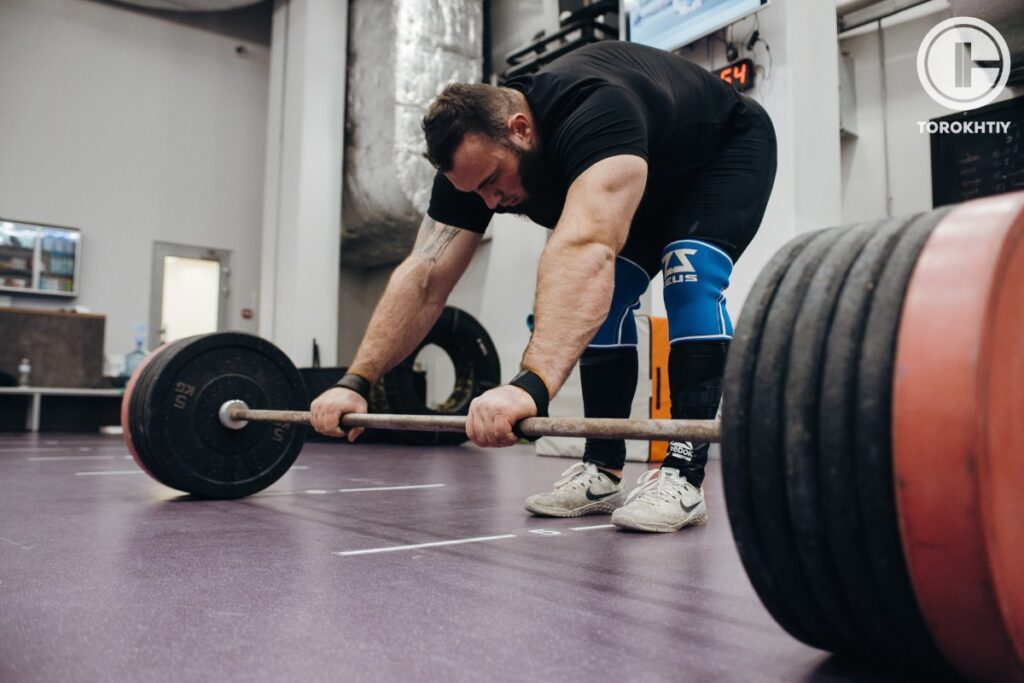
Moreover, strongmen usually prioritize developing functional strength, power, and overall athleticism. This requires more body weight and muscle mass to perform such movements as truck pulls, log lifts, stone carries, etc.
Also, since strongman competitions often include events that require lifting or moving extremely heavy objects, which may necessitate a larger overall body size for leverage and stability.
The Role of Diet in Strongman
Strongmen often carry a heavy body weight except for extreme weights. This way, they succeed in lifting, pulling, and pushing extreme weights. But excess body fat can’t benefit strongmen, however, some claim that heavy body weight can be helpful in performing some movements.
Although, like with bodybuilding preparation for competitions, nutrition and proper diet are essential parts of a strongman training regime because each competition requires an athlete ultimate performance, strength, and endurance.
Strength-oriented activities require an immense amount of energy, which can be achieved from a healthy and balanced diet.
Every athlete who’s involved in strongman training, should remember that while training like a strongman, they need to keep in mind that food is a fuel for working out and fuel for recovery.
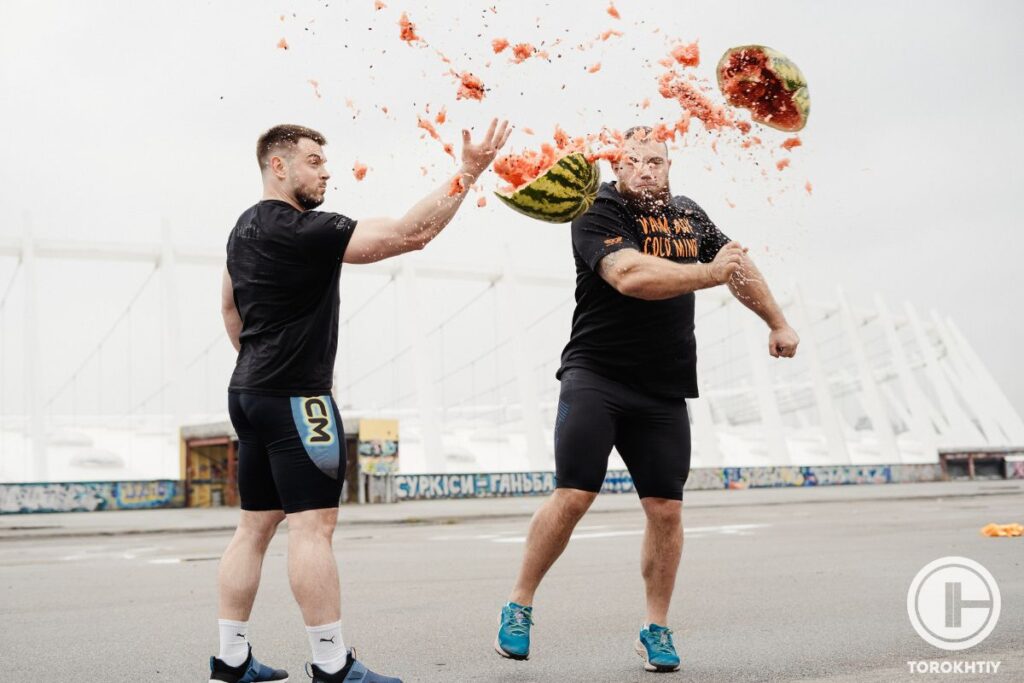
1. Why Do Strongmen Consume More Calories and How This Relates to Their Training Goals?
Strongman training isn’t just about getting stronger, it’s also about developing explosive power, mental toughness, conditioning, and sure, strength.
Calorie consumption is one of the most crucial points that determine the efficiency of a strongman training regime. As usual, strength athletes burn a great amount of calories during the workout.
So, it means they need to consume even more calories to fuel their bodies and create a reserve for gaining their peak performance.
If the goal is to gain muscle mass as quickly as possible, it’s possible to get a large calorie surplus. But, at the same time, a large calorie surplus can lead to fat gain and an unfavorable ratio of fat tissue to muscle mass.
Consequently, lots of time will be wasted on dropping body fat down. Too large rate of a calorie surplus is unbeneficial because it slows down the long process of getting into the ideal physique.
2. The Importance of Adequate Caloric Intake to Maintain Energy and Strength
Strongmen must fuel their bodies with the correct food for maximum performance. It means taking up progressive overloads of nutrients along with the competition preparation and a well-built training plan to ensure their bodies be able to adapt quickly to vigorous workouts and respond optimally to training demands.
It’s true that it’s quite difficult to preserve significant strength while being in a caloric deficit because the body requires lots of energy to build and maintain muscle mass.
However, there are viewpoints that it is possible to preserve strength by minimizing muscle loss with the help of resistance training and appropriate protein intake while being in a caloric deficit.
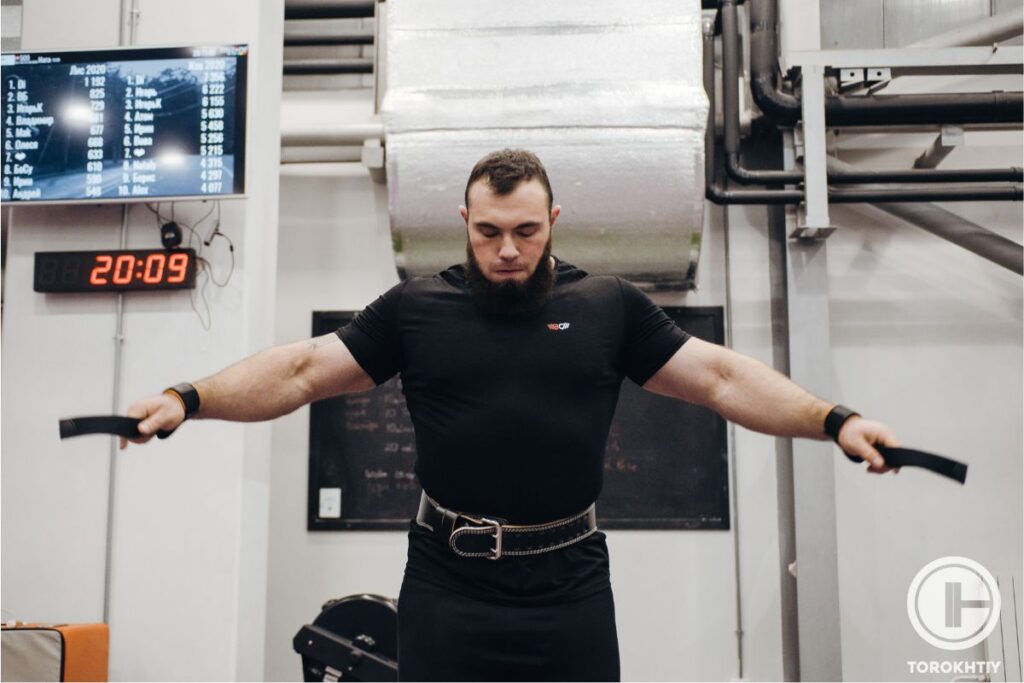
Let’s review a particular example: a four-time World Strongman Brian Shaw eats over 10,000 calories per day to fuel his intensive drills. Before the competition, he gets the following ratio of macronutrients each day: 140 grams of protein, 240 carbs, 95.5 grams of fat, with 2,260 calories.
Just to mention: an athlete eats more than the Food and Drug Administration’s (FDA) daily recommendation of 2,000 daily calories. The proper amount of protein helps him to replenish his muscles from previous training. While the carbs increase glycogen rate to use as energy for the next training.
Another sample is Mariusz Pudzianowski, a Polish former strongman competitor, has lower weight than other athletes and was looking like a bodybuilder due to proper diet regime.
He’s considered to be one of the greatest strength athletes of all times: he possesses 43 international wins at a record 70% winning percentage in his strongman career.
Hormonal and Metabolic Aspects
Hormones play a great role in athletic performance. Athletes rely on hormone levels to manage their performance at their best.
Hormones are chemical messengers that are important in regulating energy levels while training: i.e., growth hormone and thyroxine play a key role in supporting healthy body composition and bone health. Testosterone is crucial for building muscle mass and strength, while estrogen preserves bone health and prevents injury.
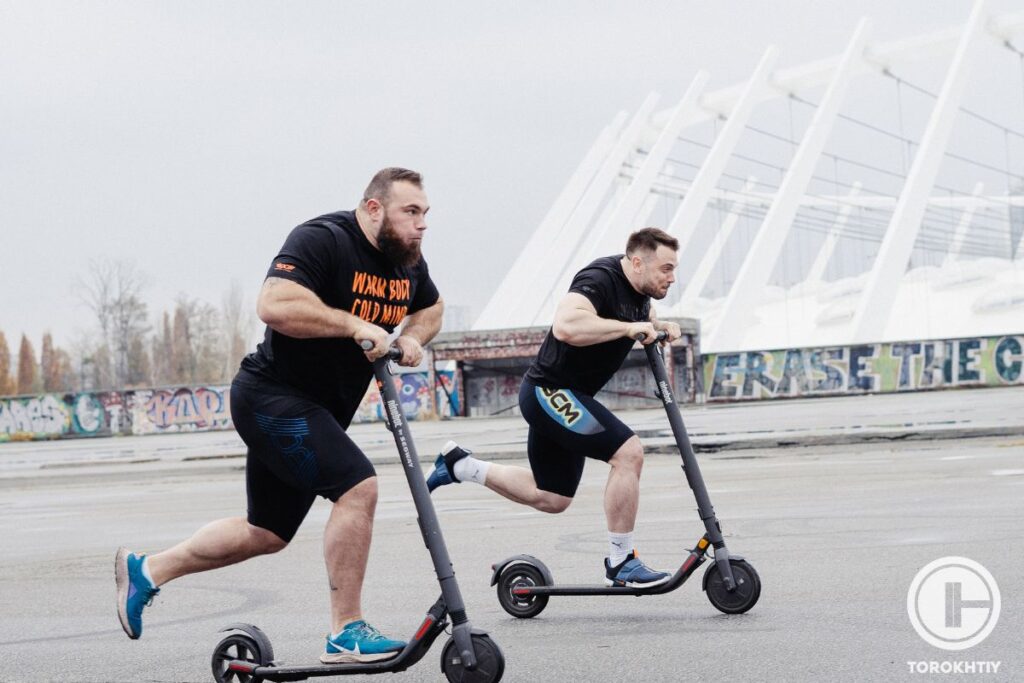
Cortisol helps to regulate the body’s stress response and adaptation to intensive activities and can affect muscle breakdown. Thyroid hormones control metabolism and energy levels.
Also, the release of particular hormones during training can promote adaptive changes in the body, resulting in improved athletic performance. Hormones regulate various physiological processes like metabolism, growth, and stress response.
For athletes, hormonal regulation is essential for maintaining optimal performance and gaining peak physical condition during the pre-competition phase and during the events.
Conclusion
To sum up, here’s the point why are strongmen fat. They tend to look bulky and fat, with big muscles at the same time, since they preserve more body fat that helps them to work out with more weight.
Since they follow a high-calorie diet predominantly that includes a significant amount of carbs and protein, it can result in the increase in body weight and a large belly!
Also Read:
- Strong woman competitions: History & Current State
- Strongman Vs Bodybuilding: Which Path to Choose?
- Effective Strongman Training Program to Gain Max Strength
- 10 Strongest Women in the World: From the Origin Till Now
- Effective Strongman Training Program to Gain Max Strength
- Why are Strongman Fat: Organism Adaptations, Proper Diet & Training
References:
- Kraemer William J.; Caldwell Lydia K.; Post Emily M. “Body Composition in Elite Strongman Competitors.”, Journal of Strength and Conditioning Research, No. 34(12), (2020): 3326-3330.
- Jamie J Ghigiarelli et al. “Effects of strongman training on salivary testosterone levels in a sample of trained men”, Journal of Strength and Conditioning Research, no. 27(3) (2013): 738-747.
- A J Chappell et al. “Nutritional strategies of high level natural bodybuilders during competition preparation.”, Journal of International Society of Sports Nutrition, 15:15:4, 2018.
- William J Kraemer et al. “Hormonal responses and adaptations to resistance exercise and training”, Sports Medicine, no. 35(4) (2005): 339-361.
- “How to Understand and Use the Nutrition Facts Label”, https://www.fda.gov/food/nutrition-facts-label/how-understand-and-use-nutrition-facts-label#:~:text=2%2C000%20calories%20a%20day%20is,.gov%2Fmyplate%2Dplan.
- “Diet and Health: Implications for Reducing Chronic Disease Risk. Calories: Total Macronutrient Intake, Energy Expenditure, and Net Energy Stores”, National Research Council (US) Committee on Diet and Health. Washington (DC): National Academies Press (US); 1989.
- Photos made by Torokhtiy Media Team.
Why Trust Us?
With over 20 years in Olympic weightlifting, strength training, nutrition coaching, and general fitness our team does its best to provide the audience with ultimate support and meet the needs and requirements of advanced athletes and professional lifters, as well as people who strive to open new opportunities and develop their physical capabilities with us.
By trusting the recommendations of our certified experts in coaching, nutrition, and sports training programming, as well as scientific consultants, and physiotherapists, we provide you with thorough, well-considered, and scientifically proven content. All the information given in the articles concerning workout programming, separate exercises, and athletic performance, in general, is based on verified data.
The product testing process is described in more detail here.
Author: Sergiy Osipchyk
Strongman Coach,
Former coach of Oleksiy Novikov and Pavlo Nakonechnyy
Strongman Experience: 10+ years
Sergiy has been involved in strength sports since he was 10 years old, and already started coaching when he was just 15 years old.
He helps clients of any age and experiences achieve results using an individual approach, daily process control, consultation and training knowledge and techniques, total experience is more than 20,000 individual training sessions.
Sergiy has trained a roster of renowned PRO strongman athletes including Oleksii Novikov, Pavlo Nakonechnyy and many other.
Reviewed by: Oleksiy Torokhtiy
Olympic Weightlifting Champion, PhD in Sport Science
Best Results: Snatch – 200 kg,
C&J – 240 kg
Oleksiy Torokhtiy is a professional athlete boasting 20 years of experience in Olympic weightlifting. With multiple European and World titles under his belt, he has showcased his prowess in two Olympic Games (Beijing 2008 and London 2012). Upon concluding his illustrious career, Oleksiy dedicated himself to coaching. By 2022, he had conducted over 200 weightlifting seminars worldwide. He is the visionary behind an international sportswear and accessories brand known for its motto, “Warm Body Cold Mind.” Additionally, he is an esteemed author and the creator of a series of training programs and eBooks.




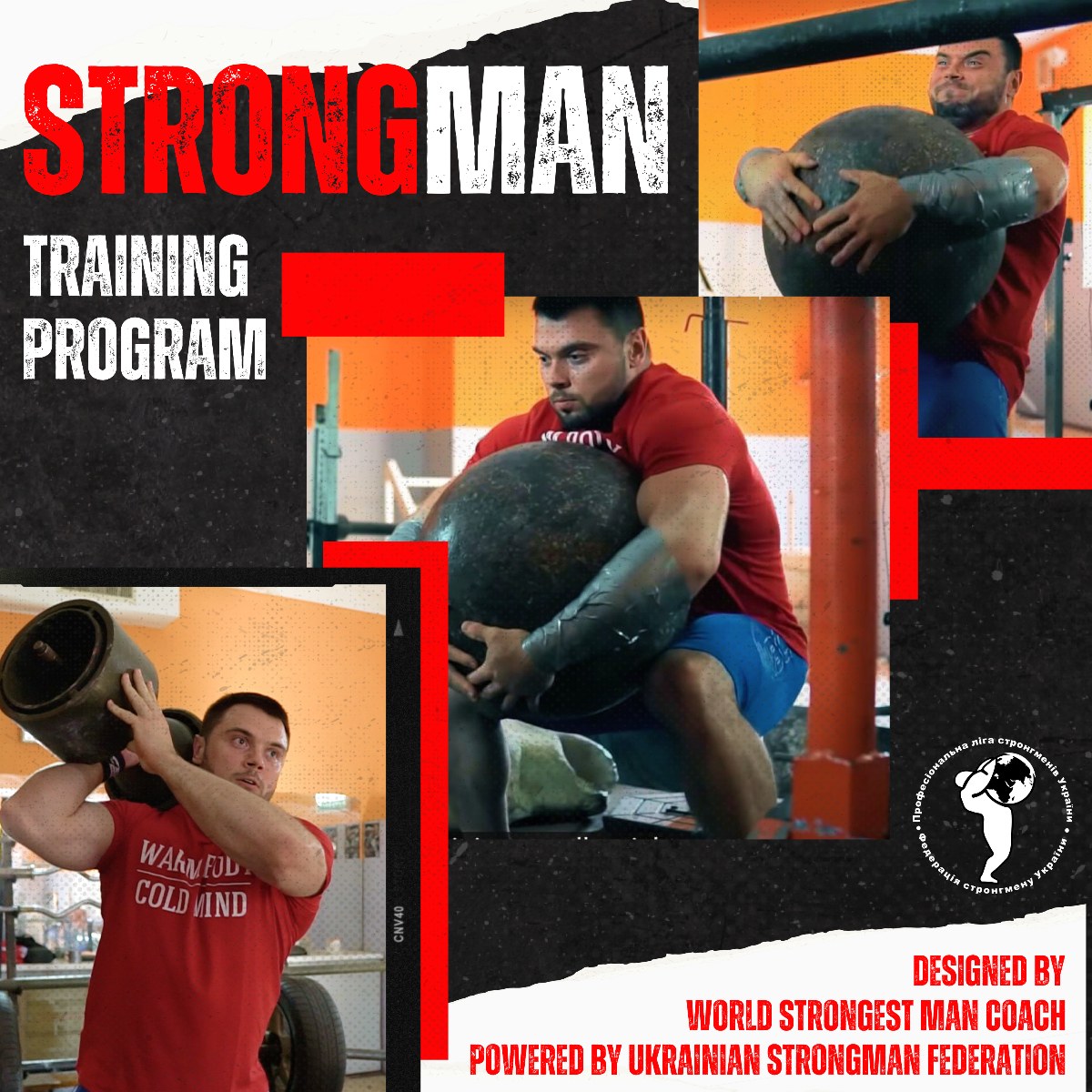
Still have questions after reading our article? Unlock your full potential by engaging with our experts and community! Don’t hesitate — leave a comment below and Sergiy Osipchyk will provide a personalized answer and insights to help you reach your goals.